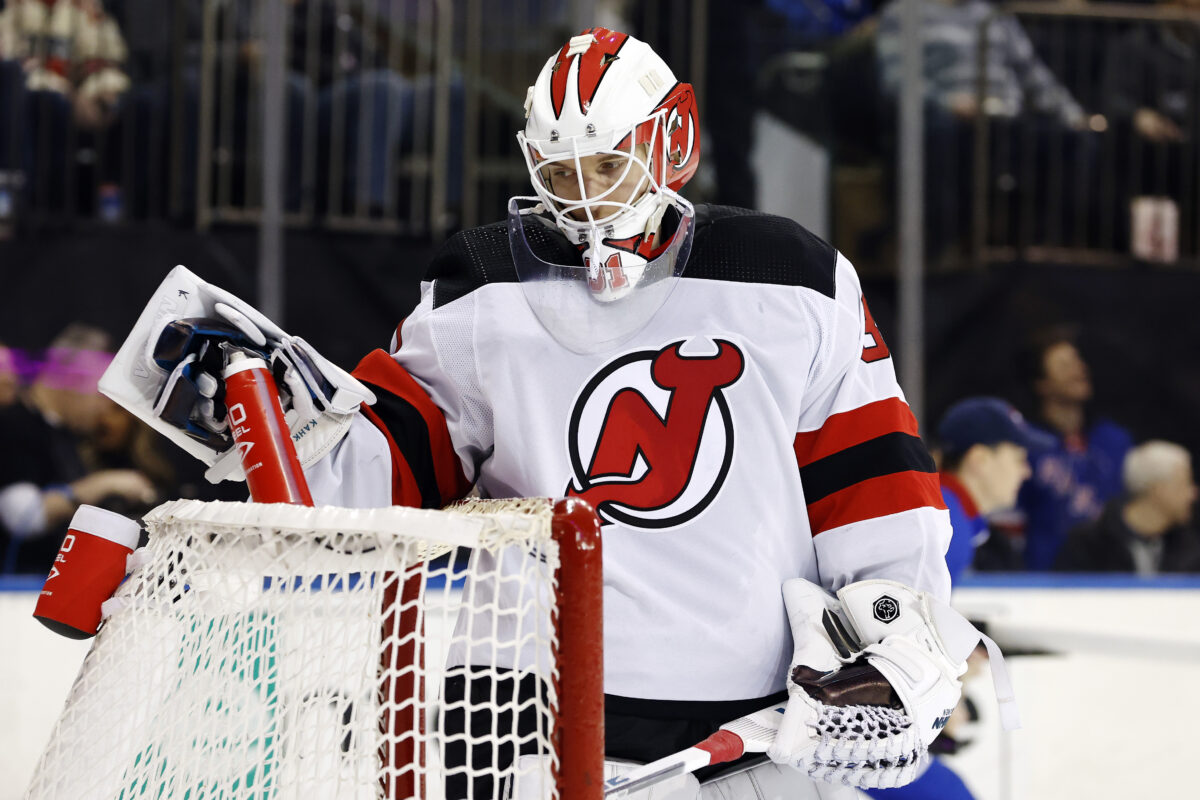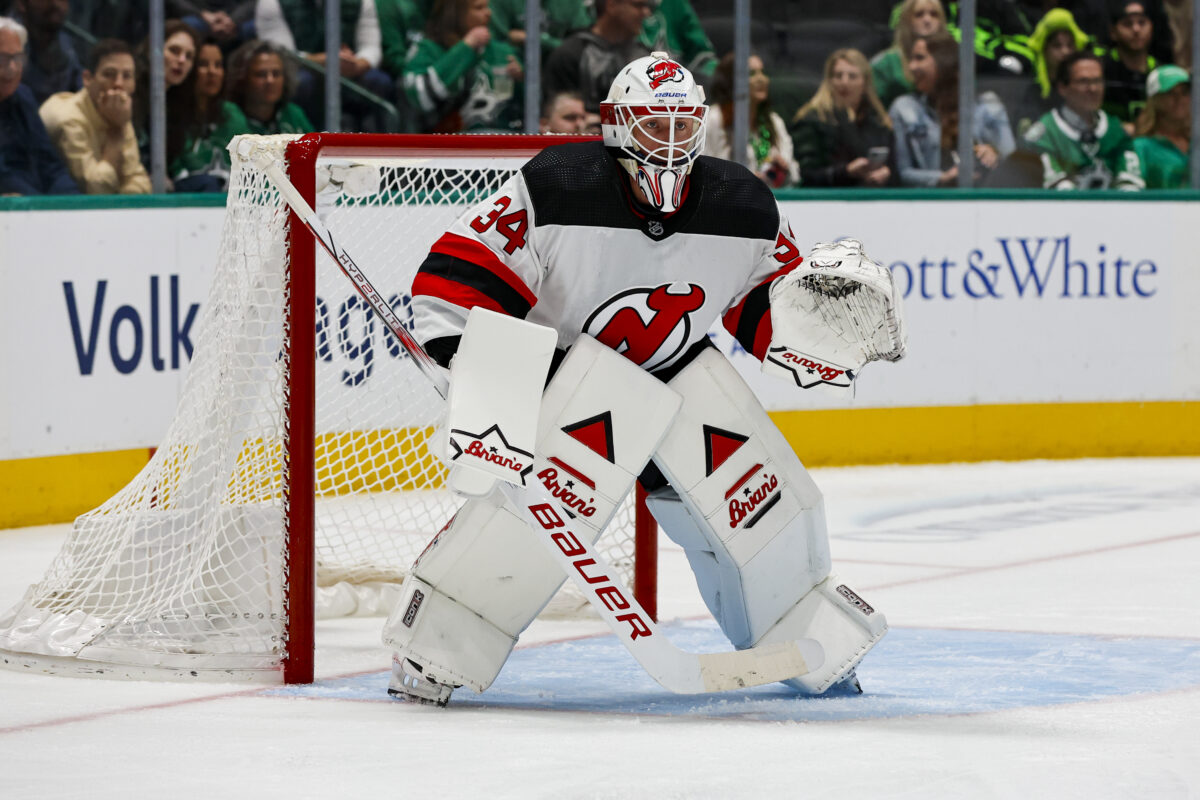The New Jersey Devils’ goaltending situation has been a catastrophe, with their .892 save percentage (SV%) ranking second-worst in the league. In the final hours leading up to the trade deadline, they dealt a struggling Vitek Vanecek to the San Jose Sharks in exchange for pending unrestricted free agent (UFA), Kaapo Kahkonen. They also acquired 33-year-old Jake Allen from the Montreal Canadiens, who has one additional year left on his deal.
In general manager Tom Fitzgerald’s presser following the moves, he seemed to make it obvious that Kahkonen was only a temporary add: “This (trade) wasn’t about (Kahkonen). It wasn’t about the goalie. It was about the flexibility that this move gives us.”
Later, speaking on the Allen deal, he mentioned: “It wasn’t really about the remainder of this year with Jake…but it was more moving forward, once he gets back into rhythm…we’re looking at a potential tandem that could rank up there in the league, if I was to land one of those big fishes.”
It’s totally understandable that they’d prefer a veteran with more experience as a backup next season over a 27-year-old Kahkonen…especially when that veteran already has an extra year on his deal. The question, though, is why Kahkonen isn’t even given a chance to make a case for himself. Because after all, it’s a results-oriented league. Production should matter way more than age and experience, especially for a team like the Devils who are in crucial need of quality goaltending.
Healthy Competition
In a perfect world, the two goaltenders perform similarly during this final stretch, allowing the Devils to make the easy choice of letting the UFA in Kahkonen walk. But currently, I don’t believe there’s enough justification to instantly come out and say Allen will get the gig over Kahkonen next season.
Let’s say, in theory, Kahkonen lights it up down the stretch and Allen falters, a la Andrew Hammond in 2021-22. The Devils initially gave up a second-round pick for him, in which the Canadiens retained 50 percent of his salary. In a league mostly starved for goaltending, it’s hard to imagine the Devils wouldn’t be able to shed the remaining ~$1.9 million and sign Kahkonen to a similar deal.

For reference, Kahkonen’s current deal is $2.75 million. No matter how he performs down the stretch, it’s going to be hard for him to overcome his 6-20-3 record with an .895 SV% – mostly a product of an abysmal Sharks’ defense. That means his price will stay relatively low after this season.
So again, in this theoretical instance where Kahkonen majorly outperforms Allen, what does that say if the Devils stick with the lesser-performing one all to save ~$1 million towards the cap?
At the very least, it shouldn’t have been outwardly said that they plan for Allen next season, even though he’s an obvious preference. The worst it could’ve done is induce some healthy competition between two netminders who have had success in the past, and push them a little harder as the Devils still have an outside shot at a wild card position.
Why Kahkonen?
The purpose of this isn’t just to be theoretical, though. There’s plenty of legitimate reason to believe that long term, Kahkonen could excel more so than Allen in New Jersey.
First, Kahkonen’s most redeeming quality in his netminding is precisely what the Devils need help most with – high danger opportunities.
The Devils are actually in the top half of the league in terms of minimizing the number of high-danger chances allowed (HDCA). Their 754 HDCA is less than the Vegas Golden Knights, Winnipeg Jets, Toronto Maple Leafs, Vancouver Canucks, New York Rangers and Boston Bruins – all of whom sit in comfortable playoff spots (via Natural Stat Trick).
Related: Devils Paying the Price Without Dougie Hamilton
The difference is that for the Devils, 122 of those chances have ended up in the back of the net, trailing only the Chicago Blackhawks (129) for worst in the NHL. That means 54.2% of the goals the Devils have given up this season are of the high-danger variety.
While the surface numbers for Kahkonen resemble that of a mediocre goaltender, his remarkable .829 high danger save percentage (HDSV%) trails only Jonathan Quick, making him second out of 56 eligible netminders. For comparison, Nico Daws’ HDSV% of .730 ranks 43rd. Vanecek’s .641% is dead-last at number 56. And Allen’s .738% ranks 40th. None of them come even close to Kahkonen (via MoneyPuck). That could end up suiting the Devils perfectly.
Secondly, we are still unsure if Allen’s steep decline in the past two seasons is due to his age. That shouldn’t be an issue for Kahkonen anytime soon, as he’s only 27.
In the past, Kahkonen has found some success in the league. His save percentage in his first three seasons was a respectable .908. Since then, he quickly became a victim of the Sharks’ shoddy defense, notching an .888 SV% in 68 games.
The Devils, even with their current underperformance, have given up 561 fewer scoring chances and 177 fewer high-danger chances than the Sharks this season. It’ll be tough to imagine that Kahkonen’s numbers won’t improve in these circumstances.
Don’t Count Out Allen
Again, this doesn’t mean Kahkonen should be the 1B option for next season; just that he should be given a fair opportunity. Allen, himself, has built a respectable career, notching a .905 SV% or higher in each of his first nine seasons in the league.

However, his age 32 and 33 seasons have been a different story, with a combined .891 SV% and minus-25.2 goals saved above expected (GSAx). Fitzgerald cited Allen’s issues with being part of a three-man tandem in Montreal as a reason that his play took a hit. Furthermore, the Canadiens (like the Sharks) have also been a bottom-five team in the league in terms of allowing opposing chances.
Allen’s first start as a Devil kicked things off on the right foot, as he stopped 35 of 37 (.945 SV%) en route to a victory in Dallas. Kahkonen’s debut was solid as well, stopping 23 of 25 (.920%) at Madison Square Garden.
If Allen is able to build off his great first start and, in Fitzgerald’s terms, “regain his footing”, this will all be a moot point. But the organization has already received so much criticism for their goaltending decisions and the last thing they’d need would be letting an additional less than $1 million cap hit become the difference in a vital goaltending decision.
Again, the most logical route is likely to implement Allen as the 1B next season. But a little healthy competition isn’t a bad thing, and it seems unfair to instantly write off a netminder whose skillset could be very beneficial to the Devils.
Regardless of who ends up with the job, Devils fans should breathe a sigh of relief in knowing that a plan to fix the goaltending has been made very clear.
